Heart Disease, Social Determinants, and Intervention Strategies Report
VerifiedAdded on 2023/01/10
|7
|1969
|88
Report
AI Summary
This report delves into the social determinants of health, specifically focusing on heart disease within the Australian context, particularly among men in major cities. It explores the burden of heart disease, highlighting factors like tobacco use, lack of physical activity, and unhealthy diets, and how social determinants such as lifestyle, social support, and income inequality contribute to the disease's prevalence. The report proposes a public health intervention, emphasizing preventive actions, health promotion policies, and the involvement of various sectors including the health and education systems to raise awareness and encourage lifestyle changes. It recommends strategies such as smoking cessation support, increased physical activity, and drug treatment for high blood pressure, aiming to reduce the risk of cardiovascular diseases. The conclusion stresses the importance of addressing social determinants to mitigate the increasing risks associated with lifestyle changes and unhealthy habits.
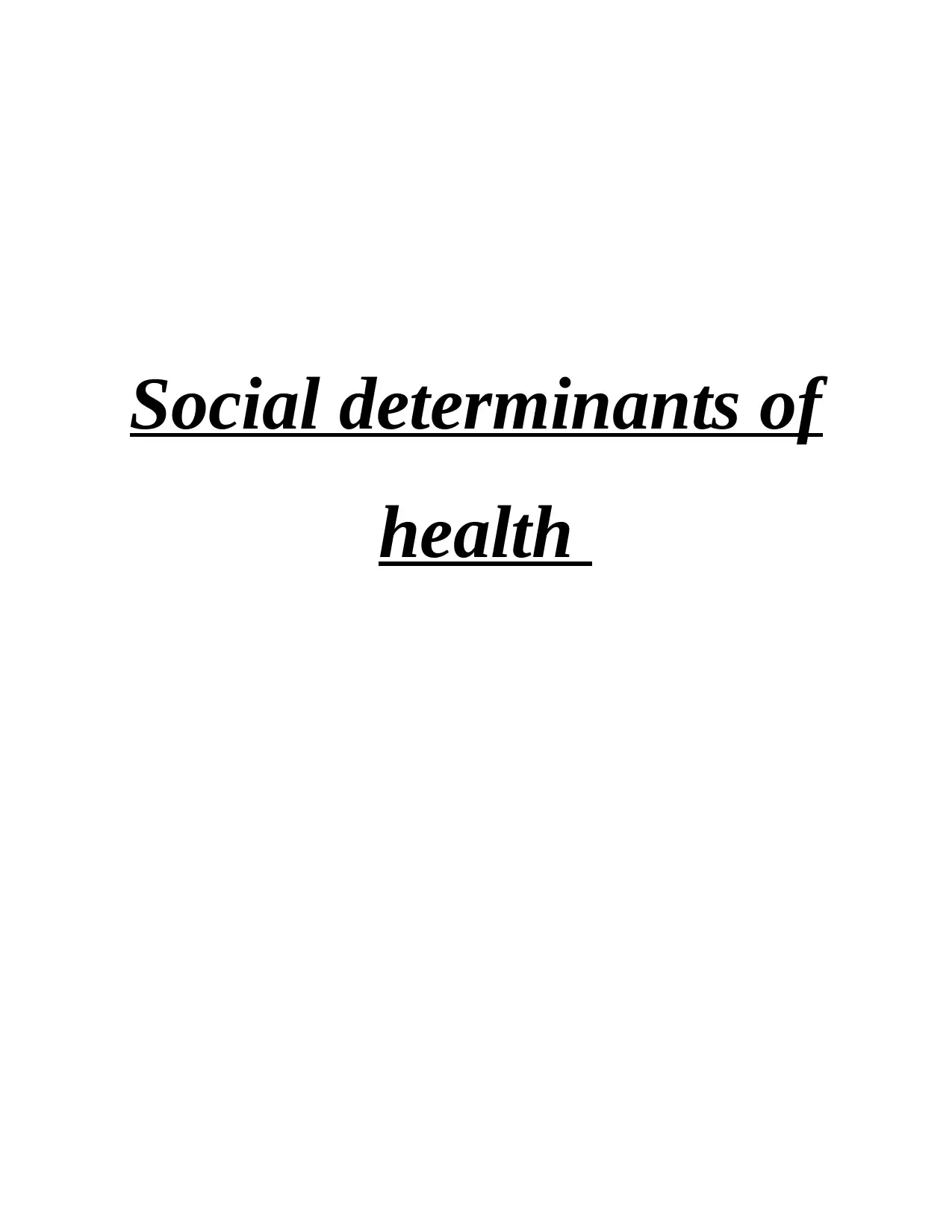
Social determinants of
health
health
Paraphrase This Document
Need a fresh take? Get an instant paraphrase of this document with our AI Paraphraser
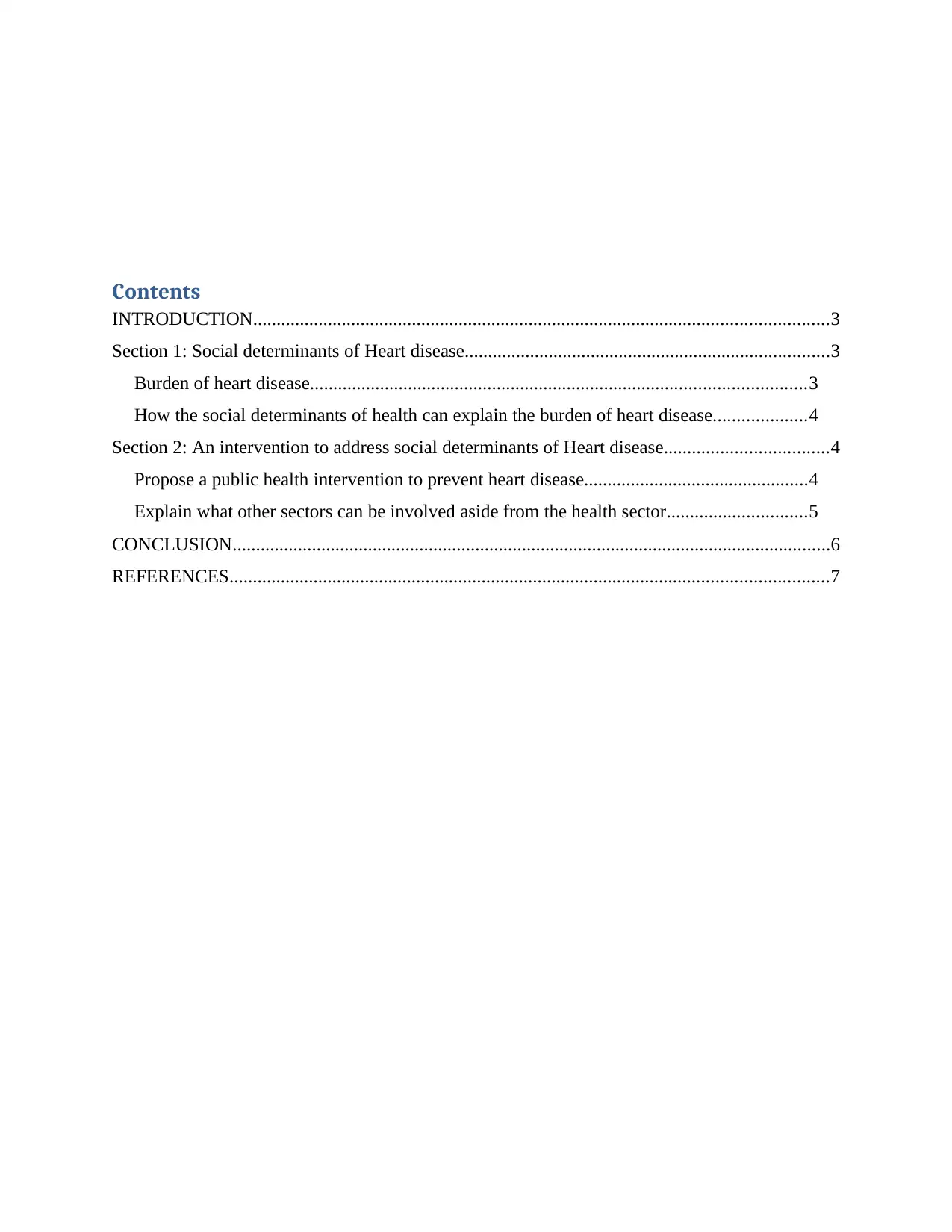
Contents
INTRODUCTION...........................................................................................................................3
Section 1: Social determinants of Heart disease..............................................................................3
Burden of heart disease..........................................................................................................3
How the social determinants of health can explain the burden of heart disease....................4
Section 2: An intervention to address social determinants of Heart disease...................................4
Propose a public health intervention to prevent heart disease................................................4
Explain what other sectors can be involved aside from the health sector..............................5
CONCLUSION................................................................................................................................6
REFERENCES................................................................................................................................7
INTRODUCTION...........................................................................................................................3
Section 1: Social determinants of Heart disease..............................................................................3
Burden of heart disease..........................................................................................................3
How the social determinants of health can explain the burden of heart disease....................4
Section 2: An intervention to address social determinants of Heart disease...................................4
Propose a public health intervention to prevent heart disease................................................4
Explain what other sectors can be involved aside from the health sector..............................5
CONCLUSION................................................................................................................................6
REFERENCES................................................................................................................................7
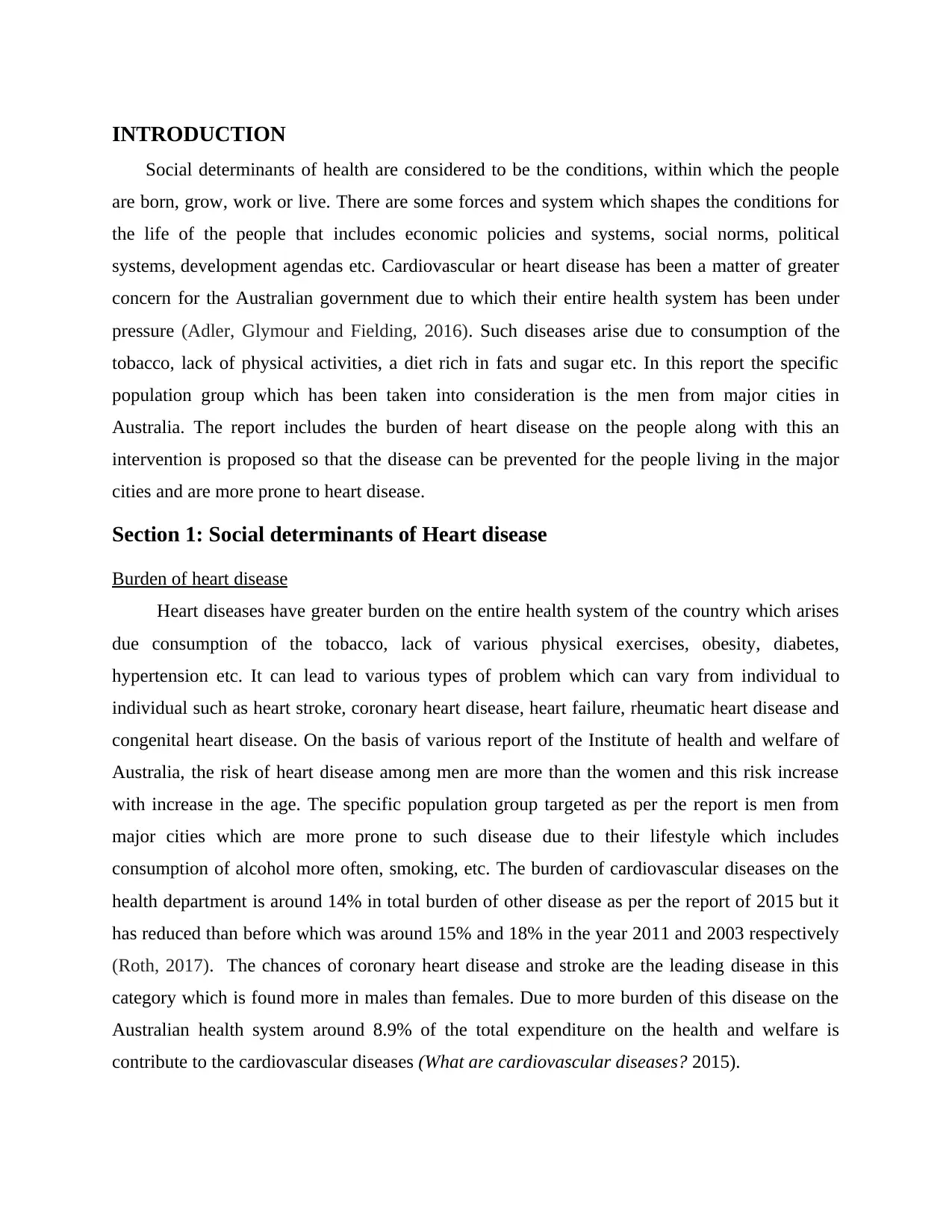
INTRODUCTION
Social determinants of health are considered to be the conditions, within which the people
are born, grow, work or live. There are some forces and system which shapes the conditions for
the life of the people that includes economic policies and systems, social norms, political
systems, development agendas etc. Cardiovascular or heart disease has been a matter of greater
concern for the Australian government due to which their entire health system has been under
pressure (Adler, Glymour and Fielding, 2016). Such diseases arise due to consumption of the
tobacco, lack of physical activities, a diet rich in fats and sugar etc. In this report the specific
population group which has been taken into consideration is the men from major cities in
Australia. The report includes the burden of heart disease on the people along with this an
intervention is proposed so that the disease can be prevented for the people living in the major
cities and are more prone to heart disease.
Section 1: Social determinants of Heart disease
Burden of heart disease
Heart diseases have greater burden on the entire health system of the country which arises
due consumption of the tobacco, lack of various physical exercises, obesity, diabetes,
hypertension etc. It can lead to various types of problem which can vary from individual to
individual such as heart stroke, coronary heart disease, heart failure, rheumatic heart disease and
congenital heart disease. On the basis of various report of the Institute of health and welfare of
Australia, the risk of heart disease among men are more than the women and this risk increase
with increase in the age. The specific population group targeted as per the report is men from
major cities which are more prone to such disease due to their lifestyle which includes
consumption of alcohol more often, smoking, etc. The burden of cardiovascular diseases on the
health department is around 14% in total burden of other disease as per the report of 2015 but it
has reduced than before which was around 15% and 18% in the year 2011 and 2003 respectively
(Roth, 2017). The chances of coronary heart disease and stroke are the leading disease in this
category which is found more in males than females. Due to more burden of this disease on the
Australian health system around 8.9% of the total expenditure on the health and welfare is
contribute to the cardiovascular diseases (What are cardiovascular diseases? 2015).
Social determinants of health are considered to be the conditions, within which the people
are born, grow, work or live. There are some forces and system which shapes the conditions for
the life of the people that includes economic policies and systems, social norms, political
systems, development agendas etc. Cardiovascular or heart disease has been a matter of greater
concern for the Australian government due to which their entire health system has been under
pressure (Adler, Glymour and Fielding, 2016). Such diseases arise due to consumption of the
tobacco, lack of physical activities, a diet rich in fats and sugar etc. In this report the specific
population group which has been taken into consideration is the men from major cities in
Australia. The report includes the burden of heart disease on the people along with this an
intervention is proposed so that the disease can be prevented for the people living in the major
cities and are more prone to heart disease.
Section 1: Social determinants of Heart disease
Burden of heart disease
Heart diseases have greater burden on the entire health system of the country which arises
due consumption of the tobacco, lack of various physical exercises, obesity, diabetes,
hypertension etc. It can lead to various types of problem which can vary from individual to
individual such as heart stroke, coronary heart disease, heart failure, rheumatic heart disease and
congenital heart disease. On the basis of various report of the Institute of health and welfare of
Australia, the risk of heart disease among men are more than the women and this risk increase
with increase in the age. The specific population group targeted as per the report is men from
major cities which are more prone to such disease due to their lifestyle which includes
consumption of alcohol more often, smoking, etc. The burden of cardiovascular diseases on the
health department is around 14% in total burden of other disease as per the report of 2015 but it
has reduced than before which was around 15% and 18% in the year 2011 and 2003 respectively
(Roth, 2017). The chances of coronary heart disease and stroke are the leading disease in this
category which is found more in males than females. Due to more burden of this disease on the
Australian health system around 8.9% of the total expenditure on the health and welfare is
contribute to the cardiovascular diseases (What are cardiovascular diseases? 2015).
⊘ This is a preview!⊘
Do you want full access?
Subscribe today to unlock all pages.

Trusted by 1+ million students worldwide
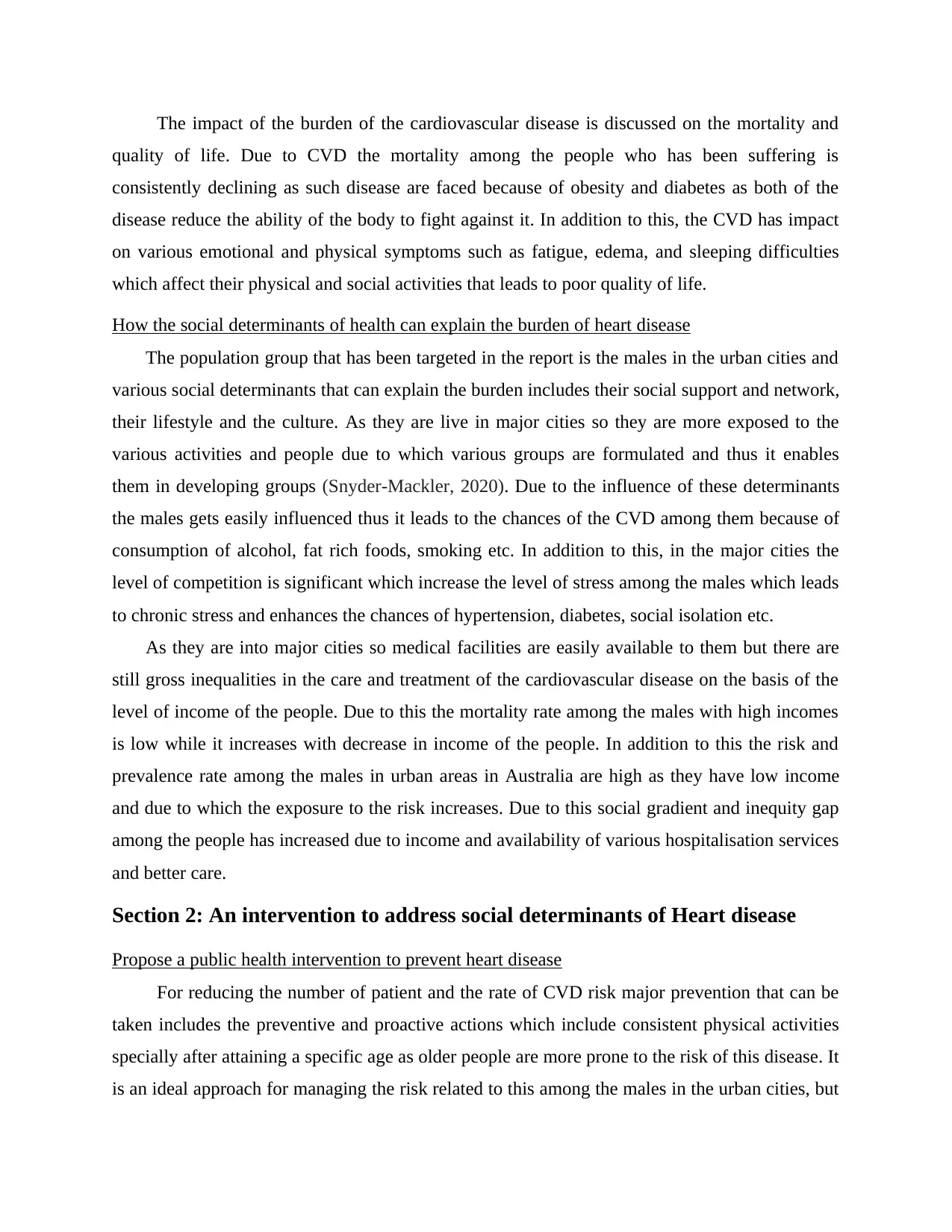
The impact of the burden of the cardiovascular disease is discussed on the mortality and
quality of life. Due to CVD the mortality among the people who has been suffering is
consistently declining as such disease are faced because of obesity and diabetes as both of the
disease reduce the ability of the body to fight against it. In addition to this, the CVD has impact
on various emotional and physical symptoms such as fatigue, edema, and sleeping difficulties
which affect their physical and social activities that leads to poor quality of life.
How the social determinants of health can explain the burden of heart disease
The population group that has been targeted in the report is the males in the urban cities and
various social determinants that can explain the burden includes their social support and network,
their lifestyle and the culture. As they are live in major cities so they are more exposed to the
various activities and people due to which various groups are formulated and thus it enables
them in developing groups (Snyder-Mackler, 2020). Due to the influence of these determinants
the males gets easily influenced thus it leads to the chances of the CVD among them because of
consumption of alcohol, fat rich foods, smoking etc. In addition to this, in the major cities the
level of competition is significant which increase the level of stress among the males which leads
to chronic stress and enhances the chances of hypertension, diabetes, social isolation etc.
As they are into major cities so medical facilities are easily available to them but there are
still gross inequalities in the care and treatment of the cardiovascular disease on the basis of the
level of income of the people. Due to this the mortality rate among the males with high incomes
is low while it increases with decrease in income of the people. In addition to this the risk and
prevalence rate among the males in urban areas in Australia are high as they have low income
and due to which the exposure to the risk increases. Due to this social gradient and inequity gap
among the people has increased due to income and availability of various hospitalisation services
and better care.
Section 2: An intervention to address social determinants of Heart disease
Propose a public health intervention to prevent heart disease
For reducing the number of patient and the rate of CVD risk major prevention that can be
taken includes the preventive and proactive actions which include consistent physical activities
specially after attaining a specific age as older people are more prone to the risk of this disease. It
is an ideal approach for managing the risk related to this among the males in the urban cities, but
quality of life. Due to CVD the mortality among the people who has been suffering is
consistently declining as such disease are faced because of obesity and diabetes as both of the
disease reduce the ability of the body to fight against it. In addition to this, the CVD has impact
on various emotional and physical symptoms such as fatigue, edema, and sleeping difficulties
which affect their physical and social activities that leads to poor quality of life.
How the social determinants of health can explain the burden of heart disease
The population group that has been targeted in the report is the males in the urban cities and
various social determinants that can explain the burden includes their social support and network,
their lifestyle and the culture. As they are live in major cities so they are more exposed to the
various activities and people due to which various groups are formulated and thus it enables
them in developing groups (Snyder-Mackler, 2020). Due to the influence of these determinants
the males gets easily influenced thus it leads to the chances of the CVD among them because of
consumption of alcohol, fat rich foods, smoking etc. In addition to this, in the major cities the
level of competition is significant which increase the level of stress among the males which leads
to chronic stress and enhances the chances of hypertension, diabetes, social isolation etc.
As they are into major cities so medical facilities are easily available to them but there are
still gross inequalities in the care and treatment of the cardiovascular disease on the basis of the
level of income of the people. Due to this the mortality rate among the males with high incomes
is low while it increases with decrease in income of the people. In addition to this the risk and
prevalence rate among the males in urban areas in Australia are high as they have low income
and due to which the exposure to the risk increases. Due to this social gradient and inequity gap
among the people has increased due to income and availability of various hospitalisation services
and better care.
Section 2: An intervention to address social determinants of Heart disease
Propose a public health intervention to prevent heart disease
For reducing the number of patient and the rate of CVD risk major prevention that can be
taken includes the preventive and proactive actions which include consistent physical activities
specially after attaining a specific age as older people are more prone to the risk of this disease. It
is an ideal approach for managing the risk related to this among the males in the urban cities, but
Paraphrase This Document
Need a fresh take? Get an instant paraphrase of this document with our AI Paraphraser
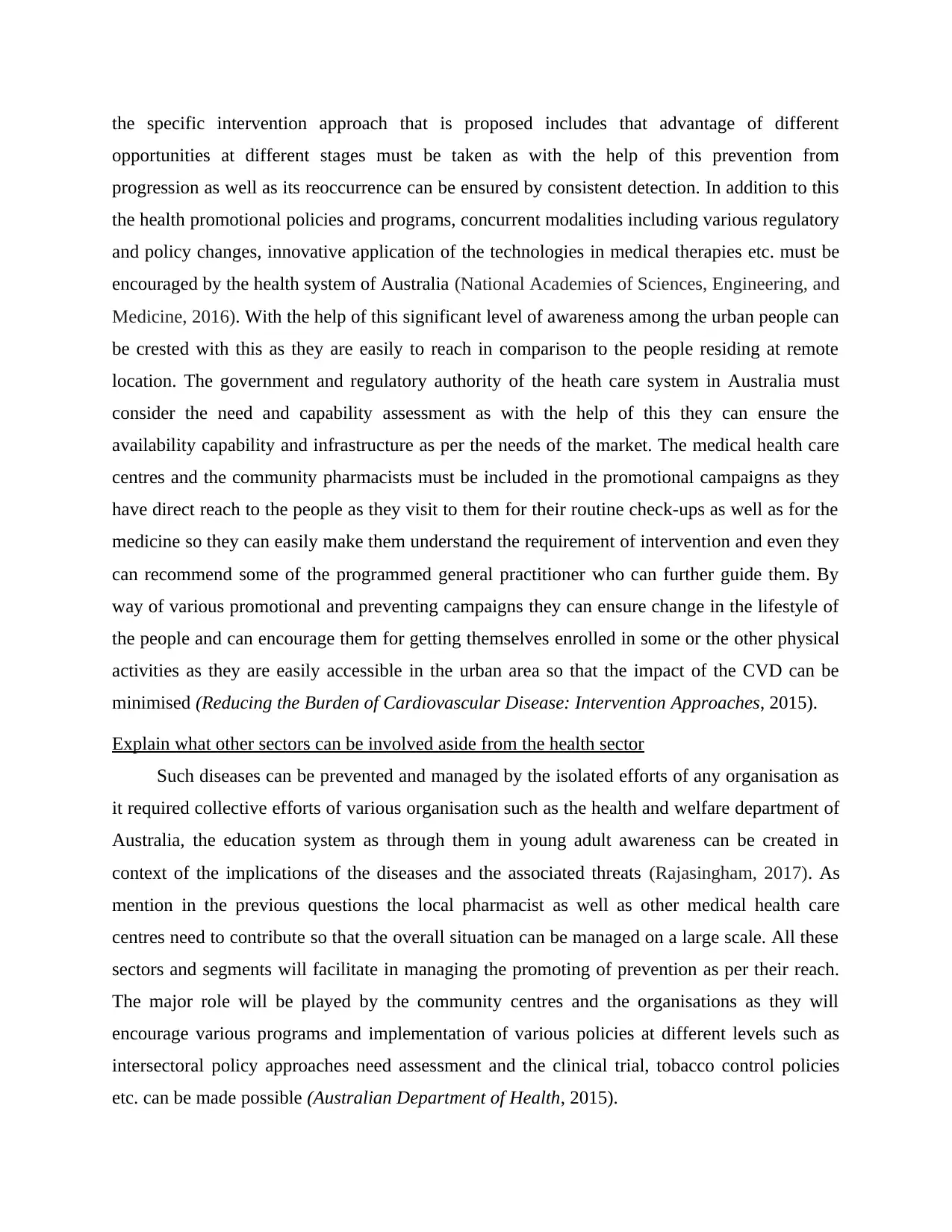
the specific intervention approach that is proposed includes that advantage of different
opportunities at different stages must be taken as with the help of this prevention from
progression as well as its reoccurrence can be ensured by consistent detection. In addition to this
the health promotional policies and programs, concurrent modalities including various regulatory
and policy changes, innovative application of the technologies in medical therapies etc. must be
encouraged by the health system of Australia (National Academies of Sciences, Engineering, and
Medicine, 2016). With the help of this significant level of awareness among the urban people can
be crested with this as they are easily to reach in comparison to the people residing at remote
location. The government and regulatory authority of the heath care system in Australia must
consider the need and capability assessment as with the help of this they can ensure the
availability capability and infrastructure as per the needs of the market. The medical health care
centres and the community pharmacists must be included in the promotional campaigns as they
have direct reach to the people as they visit to them for their routine check-ups as well as for the
medicine so they can easily make them understand the requirement of intervention and even they
can recommend some of the programmed general practitioner who can further guide them. By
way of various promotional and preventing campaigns they can ensure change in the lifestyle of
the people and can encourage them for getting themselves enrolled in some or the other physical
activities as they are easily accessible in the urban area so that the impact of the CVD can be
minimised (Reducing the Burden of Cardiovascular Disease: Intervention Approaches, 2015).
Explain what other sectors can be involved aside from the health sector
Such diseases can be prevented and managed by the isolated efforts of any organisation as
it required collective efforts of various organisation such as the health and welfare department of
Australia, the education system as through them in young adult awareness can be created in
context of the implications of the diseases and the associated threats (Rajasingham, 2017). As
mention in the previous questions the local pharmacist as well as other medical health care
centres need to contribute so that the overall situation can be managed on a large scale. All these
sectors and segments will facilitate in managing the promoting of prevention as per their reach.
The major role will be played by the community centres and the organisations as they will
encourage various programs and implementation of various policies at different levels such as
intersectoral policy approaches need assessment and the clinical trial, tobacco control policies
etc. can be made possible (Australian Department of Health, 2015).
opportunities at different stages must be taken as with the help of this prevention from
progression as well as its reoccurrence can be ensured by consistent detection. In addition to this
the health promotional policies and programs, concurrent modalities including various regulatory
and policy changes, innovative application of the technologies in medical therapies etc. must be
encouraged by the health system of Australia (National Academies of Sciences, Engineering, and
Medicine, 2016). With the help of this significant level of awareness among the urban people can
be crested with this as they are easily to reach in comparison to the people residing at remote
location. The government and regulatory authority of the heath care system in Australia must
consider the need and capability assessment as with the help of this they can ensure the
availability capability and infrastructure as per the needs of the market. The medical health care
centres and the community pharmacists must be included in the promotional campaigns as they
have direct reach to the people as they visit to them for their routine check-ups as well as for the
medicine so they can easily make them understand the requirement of intervention and even they
can recommend some of the programmed general practitioner who can further guide them. By
way of various promotional and preventing campaigns they can ensure change in the lifestyle of
the people and can encourage them for getting themselves enrolled in some or the other physical
activities as they are easily accessible in the urban area so that the impact of the CVD can be
minimised (Reducing the Burden of Cardiovascular Disease: Intervention Approaches, 2015).
Explain what other sectors can be involved aside from the health sector
Such diseases can be prevented and managed by the isolated efforts of any organisation as
it required collective efforts of various organisation such as the health and welfare department of
Australia, the education system as through them in young adult awareness can be created in
context of the implications of the diseases and the associated threats (Rajasingham, 2017). As
mention in the previous questions the local pharmacist as well as other medical health care
centres need to contribute so that the overall situation can be managed on a large scale. All these
sectors and segments will facilitate in managing the promoting of prevention as per their reach.
The major role will be played by the community centres and the organisations as they will
encourage various programs and implementation of various policies at different levels such as
intersectoral policy approaches need assessment and the clinical trial, tobacco control policies
etc. can be made possible (Australian Department of Health, 2015).
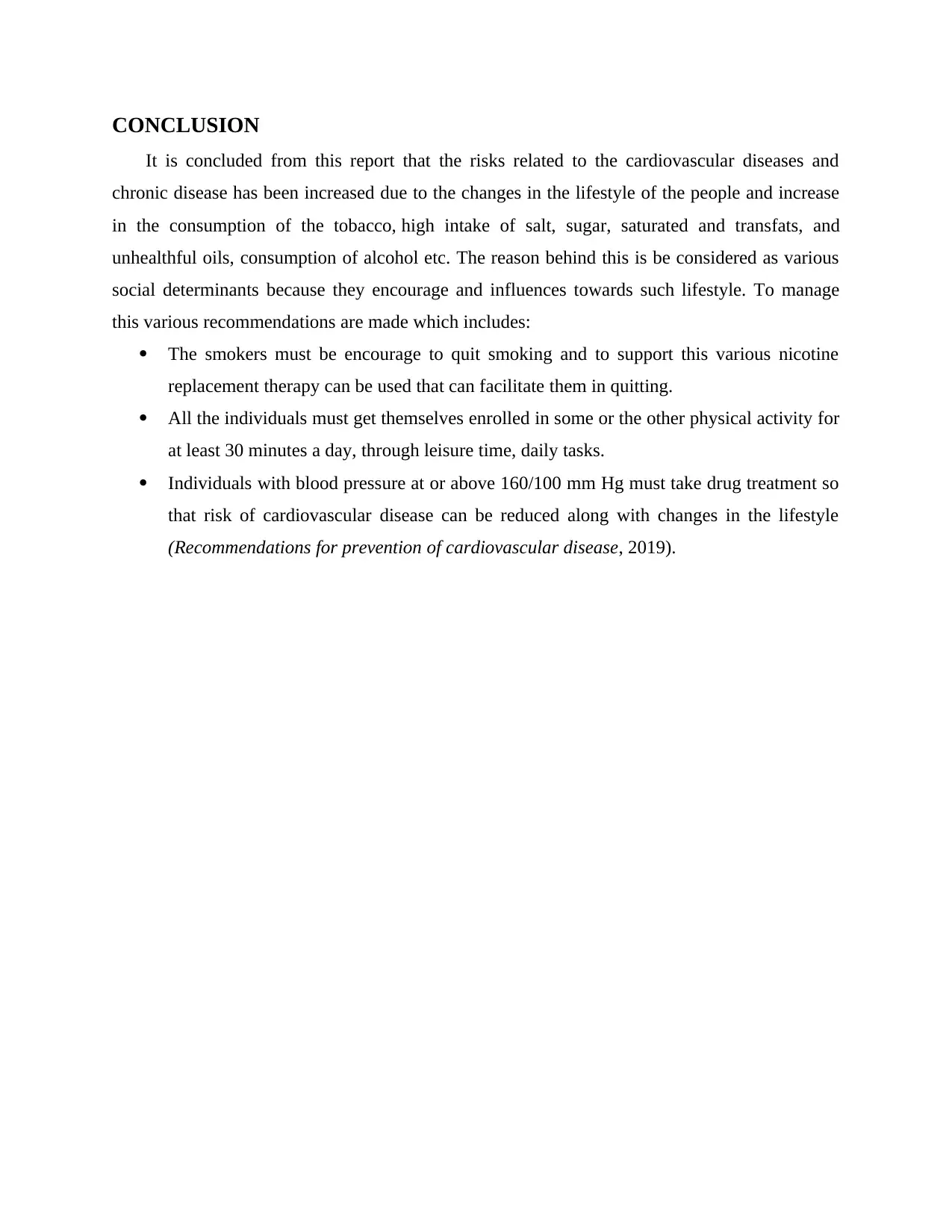
CONCLUSION
It is concluded from this report that the risks related to the cardiovascular diseases and
chronic disease has been increased due to the changes in the lifestyle of the people and increase
in the consumption of the tobacco, high intake of salt, sugar, saturated and transfats, and
unhealthful oils, consumption of alcohol etc. The reason behind this is be considered as various
social determinants because they encourage and influences towards such lifestyle. To manage
this various recommendations are made which includes:
The smokers must be encourage to quit smoking and to support this various nicotine
replacement therapy can be used that can facilitate them in quitting.
All the individuals must get themselves enrolled in some or the other physical activity for
at least 30 minutes a day, through leisure time, daily tasks.
Individuals with blood pressure at or above 160/100 mm Hg must take drug treatment so
that risk of cardiovascular disease can be reduced along with changes in the lifestyle
(Recommendations for prevention of cardiovascular disease, 2019).
It is concluded from this report that the risks related to the cardiovascular diseases and
chronic disease has been increased due to the changes in the lifestyle of the people and increase
in the consumption of the tobacco, high intake of salt, sugar, saturated and transfats, and
unhealthful oils, consumption of alcohol etc. The reason behind this is be considered as various
social determinants because they encourage and influences towards such lifestyle. To manage
this various recommendations are made which includes:
The smokers must be encourage to quit smoking and to support this various nicotine
replacement therapy can be used that can facilitate them in quitting.
All the individuals must get themselves enrolled in some or the other physical activity for
at least 30 minutes a day, through leisure time, daily tasks.
Individuals with blood pressure at or above 160/100 mm Hg must take drug treatment so
that risk of cardiovascular disease can be reduced along with changes in the lifestyle
(Recommendations for prevention of cardiovascular disease, 2019).
⊘ This is a preview!⊘
Do you want full access?
Subscribe today to unlock all pages.

Trusted by 1+ million students worldwide
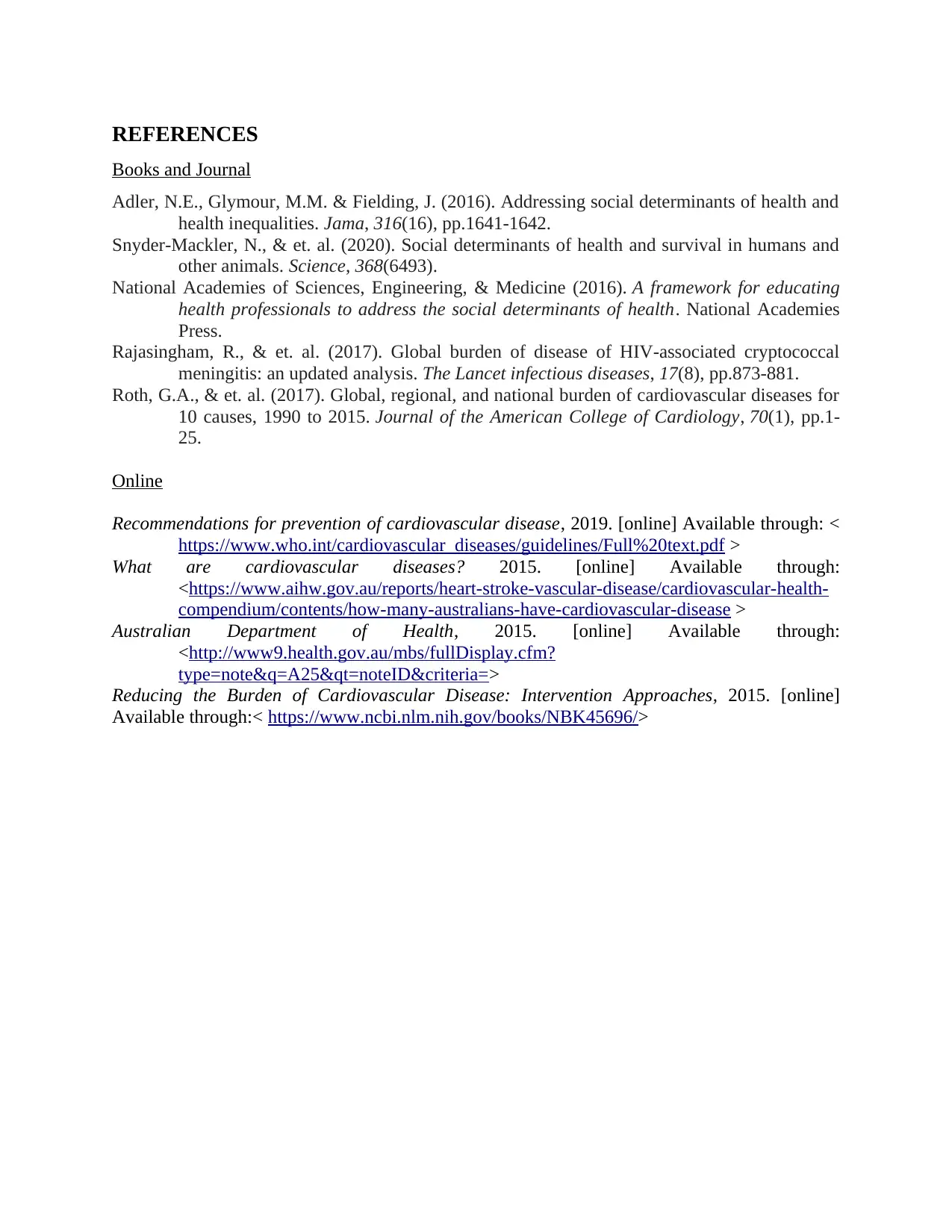
REFERENCES
Books and Journal
Adler, N.E., Glymour, M.M. & Fielding, J. (2016). Addressing social determinants of health and
health inequalities. Jama, 316(16), pp.1641-1642.
Snyder-Mackler, N., & et. al. (2020). Social determinants of health and survival in humans and
other animals. Science, 368(6493).
National Academies of Sciences, Engineering, & Medicine (2016). A framework for educating
health professionals to address the social determinants of health. National Academies
Press.
Rajasingham, R., & et. al. (2017). Global burden of disease of HIV-associated cryptococcal
meningitis: an updated analysis. The Lancet infectious diseases, 17(8), pp.873-881.
Roth, G.A., & et. al. (2017). Global, regional, and national burden of cardiovascular diseases for
10 causes, 1990 to 2015. Journal of the American College of Cardiology, 70(1), pp.1-
25.
Online
Recommendations for prevention of cardiovascular disease, 2019. [online] Available through: <
https://www.who.int/cardiovascular_diseases/guidelines/Full%20text.pdf >
What are cardiovascular diseases? 2015. [online] Available through:
<https://www.aihw.gov.au/reports/heart-stroke-vascular-disease/cardiovascular-health-
compendium/contents/how-many-australians-have-cardiovascular-disease >
Australian Department of Health, 2015. [online] Available through:
<http://www9.health.gov.au/mbs/fullDisplay.cfm?
type=note&q=A25&qt=noteID&criteria=>
Reducing the Burden of Cardiovascular Disease: Intervention Approaches, 2015. [online]
Available through:< https://www.ncbi.nlm.nih.gov/books/NBK45696/>
Books and Journal
Adler, N.E., Glymour, M.M. & Fielding, J. (2016). Addressing social determinants of health and
health inequalities. Jama, 316(16), pp.1641-1642.
Snyder-Mackler, N., & et. al. (2020). Social determinants of health and survival in humans and
other animals. Science, 368(6493).
National Academies of Sciences, Engineering, & Medicine (2016). A framework for educating
health professionals to address the social determinants of health. National Academies
Press.
Rajasingham, R., & et. al. (2017). Global burden of disease of HIV-associated cryptococcal
meningitis: an updated analysis. The Lancet infectious diseases, 17(8), pp.873-881.
Roth, G.A., & et. al. (2017). Global, regional, and national burden of cardiovascular diseases for
10 causes, 1990 to 2015. Journal of the American College of Cardiology, 70(1), pp.1-
25.
Online
Recommendations for prevention of cardiovascular disease, 2019. [online] Available through: <
https://www.who.int/cardiovascular_diseases/guidelines/Full%20text.pdf >
What are cardiovascular diseases? 2015. [online] Available through:
<https://www.aihw.gov.au/reports/heart-stroke-vascular-disease/cardiovascular-health-
compendium/contents/how-many-australians-have-cardiovascular-disease >
Australian Department of Health, 2015. [online] Available through:
<http://www9.health.gov.au/mbs/fullDisplay.cfm?
type=note&q=A25&qt=noteID&criteria=>
Reducing the Burden of Cardiovascular Disease: Intervention Approaches, 2015. [online]
Available through:< https://www.ncbi.nlm.nih.gov/books/NBK45696/>
1 out of 7
Related Documents
Your All-in-One AI-Powered Toolkit for Academic Success.
+13062052269
info@desklib.com
Available 24*7 on WhatsApp / Email
![[object Object]](/_next/static/media/star-bottom.7253800d.svg)
Unlock your academic potential
Copyright © 2020–2025 A2Z Services. All Rights Reserved. Developed and managed by ZUCOL.





